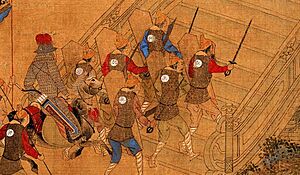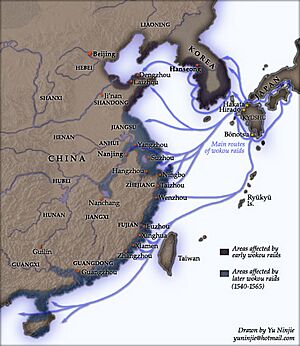Wokou facts for kids
Quick facts for kids Wokou |
|||||||||||||||||||||||||||
|---|---|---|---|---|---|---|---|---|---|---|---|---|---|---|---|---|---|---|---|---|---|---|---|---|---|---|---|

An 18th-century Chinese painting depicting a naval battle between wokou pirates and the Chinese
|
|||||||||||||||||||||||||||
| Chinese name | |||||||||||||||||||||||||||
| Chinese | 倭寇 | ||||||||||||||||||||||||||
|
|||||||||||||||||||||||||||
| Korean name | |||||||||||||||||||||||||||
| Hangul | 왜구 | ||||||||||||||||||||||||||
| Hanja | 倭寇 | ||||||||||||||||||||||||||
|
|||||||||||||||||||||||||||
| Japanese name | |||||||||||||||||||||||||||
| Kanji | 倭寇 | ||||||||||||||||||||||||||
| Kana | わこう | ||||||||||||||||||||||||||
|
|||||||||||||||||||||||||||
The Wokou (Chinese: 倭寇; pinyin: Wōkòu; Japanese: 倭寇; Hepburn: Wakō; Korean: 왜구; Hanja: 倭寇; RR: Waegu) were groups of pirates. Their name means "Japanese pirates." These pirates attacked the coastlines of China and Korea for many years. This happened from the 13th century to the 17th century.
The Wokou were made up of different groups of people. They came from various parts of East Asia. Their attacks changed over time. They often launched their raids from islands in the Sea of Japan and East China Sea. Wokou activity in Korea became less common after a special agreement in 1443. This agreement was called the Treaty of Gyehae. However, their attacks continued in Ming China. They were most frequent and powerful during the Jiajing wokou raids in the mid-16th century. Both China and Japan worked hard to stop these pirates. By the 17th century, the Wokou had mostly disappeared.
Contents
What Were the Wokou?
There were two main periods of Wokou piracy. The first group of Wokou mostly lived on islands near Japan. These islands were in the Sea of Japan. The Wokou from the 16th century were different. Most of them were not Japanese. The early Wokou even attacked Japanese coasts, as well as Chinese and Korean ones.
The word "Wokou" (倭寇) was first used a long time ago. It appears on the Gwanggaeto Stele. This stone monument was built in China. It celebrates the achievements of Gwanggaeto the Great. He was a ruler of Goguryeo from 391 to 413. The stele says that "Wokou" (meaning "Japanese robbers") crossed the sea. Gwanggaeto defeated them in the year 404. The term "Wokou" combines two Chinese words. Wō (倭) referred to the Japanese. Kòu (寇) means "bandit" or "robber."
The Early Wokou (Before the 16th Century)
The idea of Wokou goes back to the 4th century. But the "early Wokou" pirates became a big problem after the Mongol invasions of Japan. These wars weakened the coastal defenses of China and Korea. People living on islands like Tsushima, Iki, and Gotō Islands in Japan became very poor. Because of this, the Wokou started to raid the coasts of China and Korea more often.
A Korean official named Chŏng Mong-ju went to Japan to solve the problem. During his visit, a Japanese governor helped. He stopped the Wokou and returned stolen goods and people to Korea. Later, in 1405, a Japanese leader sent 20 captured pirates to China. They were punished severely in a city called Ningbo.
Korean records show that Wokou attacks were very common around 1350. They invaded southern provinces almost every year. Then they moved north. In 1380, a big sea battle happened. One hundred warships were sent to fight Japanese pirates. They freed 334 captives. After this, Wokou attacks decreased. Korea also started using gunpowder weapons. The Wokou did not have these. This helped Korea get rid of the pirates.
In 1419, the Korean army launched a large attack against the Wokou. This was called the Ōei Invasion. General Yi Jongmu led a fleet of 227 ships and over 17,000 soldiers. They sailed to Tsushima Island. Korean records say they captured many Wokou ships. They also burned houses and rescued Chinese captives. However, the Korean army also lost many soldiers. Bad weather made them leave the island.
Wokou activity near Korea calmed down after 1443. This was when the Treaty of Gyehae was signed. It gave trade rights to the Sō clan of Tsushima. You can still find old forts built to defend against Wokou attacks. Some are in Zhejiang and Fujian in China. Examples include Pucheng Fortress and Chongwu Fortress.
The Later Wokou (16th Century)

By the 16th century, the Wokou groups had changed. The History of Ming says that only about 30% of these later Wokou were Japanese. The other 70% were ethnic Chinese. One official in 1553 said that pirates were 10% "barbarian people," 20% Ryukyuan people, and the rest were from China.
A historian named Ray Huang said that Japanese pirates often worked with Chinese groups. Chinese explorers even led some pirate trips. But the main fighters were still Japanese pirates. Japan was a base for them. The Japanese also provided military skills and equipment.
The Ming dynasty in China tried to control trade. They believed that "unrestricted trade would lead to chaos." So, they made sea trade illegal. This also made China's navy weaker. As a result, they could not stop the increase in smuggling. This led to the Wokou controlling the southeastern coast. Even though "Wokou" means "Japanese pirates," many big Wokou groups in the 16th century were led by Chinese traders. Their businesses were hurt by the Ming trade bans. Some Chinese officials were even involved with the pirates. They made money from piracy. This made it hard for the government to stop them.
Two famous Chinese military leaders fought against the Wokou. They were Qi Jiguang and Yu Dayou. Yu Dayou was a general who defended the coast. In 1553, a young man named Qi Jiguang became a military leader. He was told to "punish the bandits and guard the people." This meant fighting the Wokou attacking the Ming coast. He was only 26 years old. He was very successful and was promoted the next year.
The Wokou even reached the Philippines. This happened before they were finally stopped in the 17th century. A city called Aparri in northern Luzon became a pirate city. It was supported by the Wokou. In 1582, battles happened there between Wokou and Spanish soldiers. The Wokou were not only in Aparri. A pirate leader named Limahong tried to invade Manila. He failed. Then he set up a temporary pirate state. But the Spanish soon drove him out.
| Reign period | Region | Total | |||||
|---|---|---|---|---|---|---|---|
| Liaodong | Shandong | Jiangnan | Zhejiang | Fujian | Guangdong | ||
| Hongwu (1358–1398) | 1 | 7 | 5 | 21 | 3 | 9 | 46 |
| Jianwen (1399–1402) | 2 | 2 | |||||
| Yongle (1403–1424) | 2 | 8 | 4 | 25 | 1 | 3 | 43 |
| Hongxi (1425) | 0 | ||||||
| Xuande (1426–1435) | 1 | 1 | 1 | 3 | |||
| Zhengtong (1436–1449) | 1 | 10 | 11 | ||||
| Jingtai (1450–1456) | 1 | 1 | |||||
| Tianshun (1457–1464) | 0 | ||||||
| Chenghua (1465–1487) | 1 | 1 | 2 | ||||
| Hongzhi (1488–1505) | 1 | 1 | |||||
| Zhengde (1506–1521) | 1 | 1 | 2 | ||||
| Jiajing (1522–1566) | 5 | 207 | 192 | 158 | 39 | 601 | |
| Longqing (1567–1572) | 19 | 19 | |||||
| Wanli (1573–1619) | 1 | 5 | 9 | 15 | |||
| Total | 746 | ||||||
See Also
- Piracy in the Strait of Malacca
- God of War (film)
- Limahong
- Lin Daoqian



